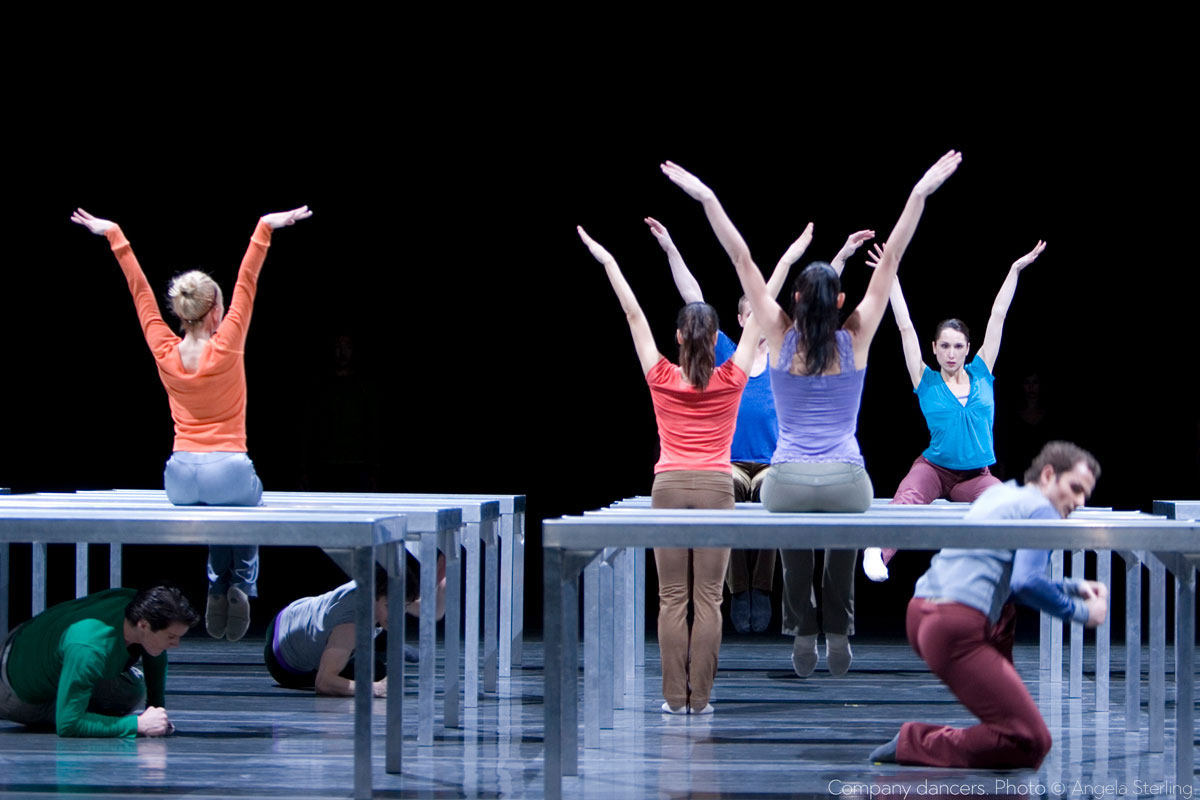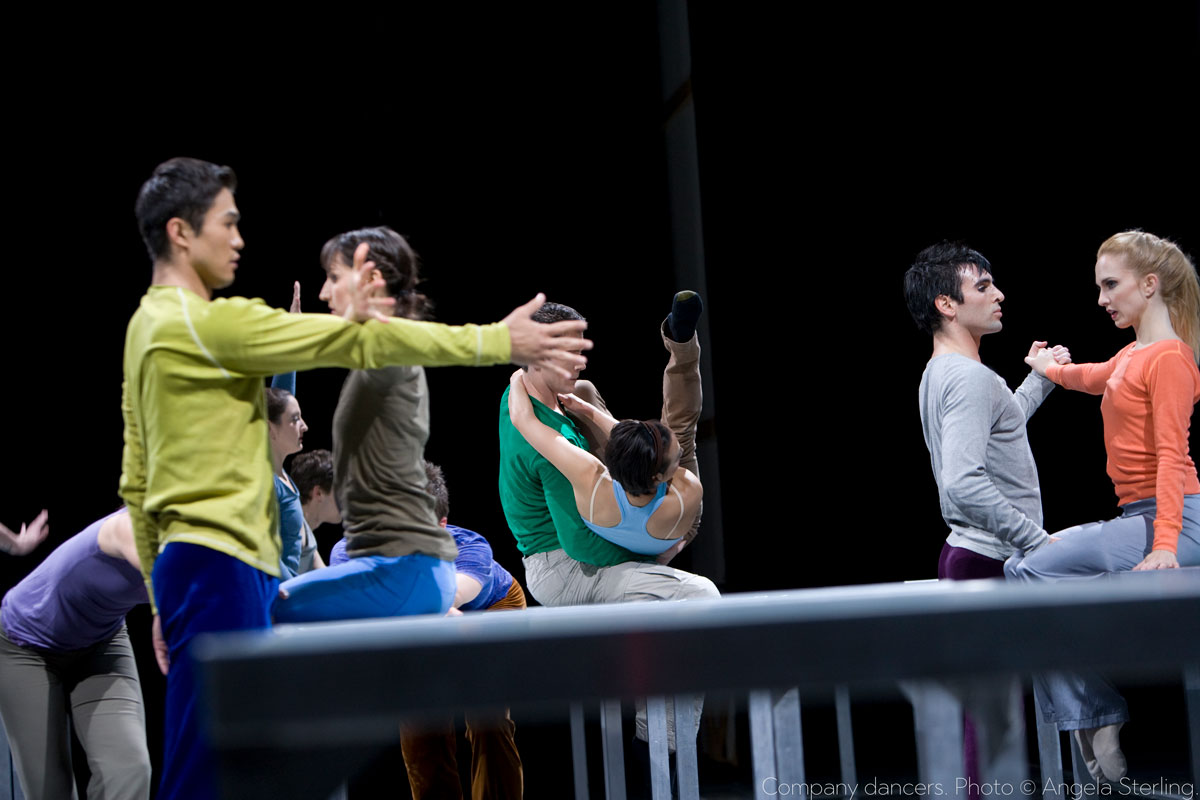Watching a complicated ballet without any prior knowledge can feel like watching the season finale of a TV show without having seen a single episode, or beginning a novel by reading the final chapter.
One Flat Thing, reproduced is a complicated dance, so consider this blog as your road map through the maze. And consider our upcoming education event to serve as your seasoned tour guide!
WHAT TO KNOW ABOUT THE DANCE
PNB performed William Forsythe’s One Flat Thing, reproduced for the first time in March 2008. Some audience members stood up and left the theater. Some critics were confused. Reviews were mixed. “[Artistic Director] Peter [Boal] doesn’t mind the sacrifice of an audience member, as long as they’ve been moved by the piece – even irritated by it,” said former PNB Principal dancer Ariana Lallone.
Seven months later, Boal brought the piece back as if to say, “Try it again, Seattle.” Audiences were much more receptive.
For the third time, Boal brings the piece to PNB’s mainstage on March 16–25. You’ll see 20 tables with 14 dancers pushing and pulling them, then dancing on top of and underneath and between them, for 14 minutes. You’ll see brief moments of synchronicity, followed by cacophony. Shapes, patterns, flows of movement.

WHAT TO KNOW ABOUT THE TABLES
One Flat Thing, reproduced is known colloquially as “the table dance.” But what do the tables mean? Why do they seem to be the object of the dancers’ attention?
The piece is inspired by the second Antarctic expedition of British naval commander Robert Falcon Scott. On his first trip to the Antarctic, Scott and companions discovered the Polar Plateau, an event which caught public attention in Britain. His second trip – the inspiration for One Flat Thing, reproduced – didn’t go as well. Scott and his companions reached the South Pole but died on the return journey. (They also discovered that Norwegian explorer Roald Amundsen beat them to the Pole by five weeks.)
Beginning in 1985, choreographer William Forsythe worked on various projects related to Scott’s journey. Fifteen years later, One Flat Thing was one of the final iterations of this fascination. Forsythe likes to think of the tables as creating a slippery, dangerous environment, much like the Polar Plateau was for Scott.

He empathizes with Scott’s arrival at the South Pole, where he found it had already been claimed by Norway. “A lot of effort was made and nothing was leftover…it’s kind of like dance.”
He also connects Scott’s determination to reach the South Pole with the restlessness and constant shifting of dancers in One Flat Thing. It’s simple, he says: “You can’t stay in the middle of the stage or else you’ll get run over.”
WHAT TO KNOW ABOUT THE CHOREOGRAPHER
Forsythe, who brought us In the Middle, Somewhat Elevated and The Vertiginous Thrill of Exactitude, is the man behind One Flat Thing, reproduced.
He believes the term choreography can mean people moving together or people not moving together. Or something else entirely.
“It’s used very often to describe a well-organized action,” he said. “Like, ‘Obama’s campaign was beautifully choreographed.'”

Forsythe is particular about the definition of choreography and how it differs from dance. “Choreography often serves as a channel for the desire to dance,” he said, but the word does not embody dance itself.
With this level of precision, Forsythe has a distinct idea about how viewers should watch One Flat Thing, reproduced as a whole. “It was composed as an entirety,” he said. “It wasn’t composed as if you’re watching just this person or that person…although you can choose to do that. For me, the composition is a whole.”
WHAT TO KNOW ABOUT THE MUSIC
The short version: The music does not direct the piece. The dancers direct the piece.
The long version: Thom Willems produced the score – a rumbling, droning composition. Willems is a frequent collaborator with Forsythe (you might remember his pounding score for In the Middle, Somewhat Elevated).
But the direction of One Flat Thing, reproduced derives from dancer cues. Breathing, eye contact, slapping a table, or yelling “go!” can trigger an action in another dancer. This is the key connection between the dance and Forsythe’s fascination with Scott’s polar expedition: physical teamwork.

The music? They could do without it. Dancers collectively determine the flow. “A domino effect is paramount as one dancer sets another into motion and one table bangs into another,” wrote Anna Kisselgoff in The New York Times.
Forsythe calls the dancers an “orchestra composed of conductors.” They’re bouncing off of one another or contradicting one another, a concept Forsythe refers to as counterpoint.
WHAT TO KNOW ABOUT COUNTERPOINT
It is counterpoint that makes One Flat Thing, reproduced so complicated. Counterpoint is the phrasing of movement in opposition to a rhythm. Counterpoint can create tension and it can be uncomfortable (think of Stravinsky Violin Concerto). Counterpoint involves complementary movements – as if choreography were a bizarre puzzle.
Think of water glittering in the ocean, Forsythe says. “It’s highly counterpointed, but there’s an order to it on some level – it hierarchically collapses.”
(If you want to dig deep into the concept of counterpoint in One Flat Thing, reproduced, visit the interactive website Synchronous Objects!)
Instead of music, Forsythe uses both counterpoint and alignment – irregular movements followed by short moments of synchronization – to create flow in One Flat Thing, reproduced. “This is a resolution… we see this as order,” he says. “Fourteen put their legs up, or they’re all facing forward.
“When you hear a new chord in music, you go, ‘oh, okay… this alignment sounds like something.’ In this case, this looks like something.”

So maybe Forsythe is trying to stress dance over music in One Flat Thing. Maybe counterpoint and alignment are his tools for doing so.
It’s an uphill battle, some would say. “There is a fear that music, as an art form and a discipline, can all too easily dominate, or overlook, the importance of dance,” writes music historian Charles M. Joseph. Almost all books about George Balanchine also mention Igor Stravinsky, but it’s not the same vice versa.
But Forsythe balances the two, partly by using a sound design rather than conventional music. Willems’ score binds One Flat Thing together with a nearly constant drone. As Kissellgoff wrote, “Nothing is static, everything is alive.”
Come see for yourself! One Flat Thing, reproduced is onstage in DIRECTOR’S CHOICE, March 16–25, 2018.
Want to learn more about One Flat Thing before diving into DIRECTOR’S CHOICE? Join Doug Fullington and Peter Boal along with PNB dancers and One Flat Thing stagers for a deep dive into the work.





